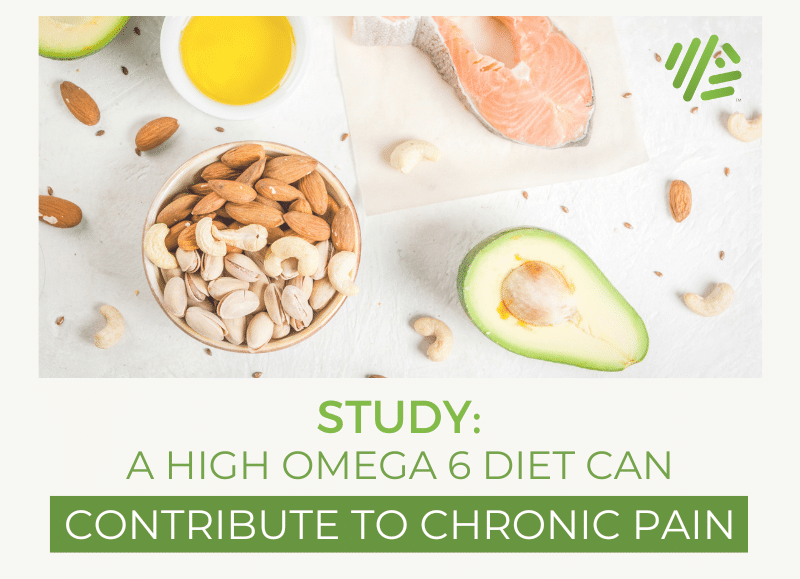Study: A High Omega 6 Diet Can Contribute to Chronic Pain

Contents
Omega 6 polyunsaturated fatty acids (PUFA’s) are a type of fat that is present in certain foods and supplements and cannot be produced by the body. Omega 6 fats also occur naturally in plant foods, such as vegetables and nuts, although some processed vegetable oils, such as soybean oil, contain high amounts of these fats as well.
Although they get a bad rap in nutrition circles, we all need some omega 6 in our diets. Besides playing important roles in brain function, these fats also stimulates skin and hair growth, maintains optimal bone health, keeps the reproductive system healthy, helps regulate metabolism, and much more.
Omega 6 regulates the pain response in a healthy system
Omega 6s are equally important in their function as omega 3’s in a balanced and healthy system.
Omega-6 PUFAs are comprised of:
- Arachidonic acid (AA)
- Linoleic acid (LA)
- Docosapentaenoic acid (DPA)
Omega-6 PUFAs contribute to several necessary inflammatory functions which include the generation of prostaglandins (inflammatory proteins) which are derived from AA. Prostaglandins are vital to the inflammatory process and are associated with the two COX enzymes (COX-1 and COX-2). During illness, these inflammatory proteins play key roles in inducing fever and resolving infections. Ibuprofen blocks the synthesis and function of these proteins, which then results in your fever dissipating.
Since omega 3 is anti-inflammatory, the levels of omega 3 and 6 should exist together in the perfect ratio so that inflammation can be induced and resolved in a regulated manner.
See also: Why Fish Oil Benefits May Hinge on Genetics
The omega 3: omega 6 ratio is important for optimum health and immunity
Research has shown that the consideration of the omega 6 and omega 3 PUFAs balance has important clinical and functional relevance. A recommended omega 6:omega 3 PUFA ratio ranges from 2:1 to 5:1. If this is exceeded, research has shown that a high omega 6:omega 3 PUFA ratio is associated with inflammation and depression in older adults.1 This is just the tip of the iceberg though – high levels of omega 6 have a broad range of negative effects on general wellness.
This was shown in an intervention that increased omega 3s and decreased omega 6 PUFAs in individuals with a skewed ratio. What they found was that the subjects had an improved overall quality of life and functioning, as well as decreased distress, headache frequency, and severity in those with chronic headaches.2
Unfortunately, omega 6 PUFA intake is excessive in the Western diet resulting in a significantly higher omega 6:omega 3 PUFA ratio. Nowadays, particularly in the U.S., many people eat far more omega-6s than omega-3s. Researchers believe that the ratio in a typical Western diet is 20:1 or higher!3
Interestingly, research suggests that early humans consumed equal amounts of omega-6 and omega-3 fatty acids in their diets and that this was beneficial to their health.4 There is a consensus that equal ratios of the fats may also be optimal.3
High omega 6 and obesity
Obesity in the U.S. has reached what some would call an epidemic- more than one-third of American adults are obese. Interestingly, research has shown that the exposure of a developing fetus/neonate to a typical Western diet increases their risk of being obese throughout their life course, creating an intergenerational cycle of metabolic disease.5 This epidemic of obesity and metabolic disease has coincided with a marked increase in the consumption of omega 6 PUFAs, leading to the likelihood that the two may be causally related.
In one study, researchers tested this to determine whether the over-consumption of omega 6 fatty acids has paralleled the significant increase in the prevalence of overweight and obese adults. The researchers found that in the past three decades, the intake of omega 6 PUFAs in the Western diet has increased, while the intake of omega 3 PUFAs decreased. The researchers emphasized that the key to reversing the obesity epidemic is to promote a proper fatty acid ratio balance.6
See also: Can Vegans get enough Omega 3?
High omega 6 levels may be the cause of chronic pain
Chronic pain is the leading cause of disability worldwide and is commonly associated with comorbid disorders like diabetes, metabolic syndrome, etc. Until now, the role of one’s diet in chronic pain was poorly understood. There have been medical recommendations about diet modifications for individuals with cardiovascular disease, diabetes, and autoimmune diseases, but this is not the case for most pain disorders…until now.
The High-Fat Western diet model, which is rich in pro-inflammatory omega 6 PUFAs, is brimming with omega-6-laden vegetable oils and processed food. Individuals with high levels of omega 6 PUFAs report inflammation, chronic pain, cognitive impairment, and psychological distress, but the reason as to why omega 6s have this effect was unknown.
A ground-breaking study published in Nature entitled “Elevated dietary ω-6 polyunsaturated fatty acids induce reversible peripheral nerve dysfunction that exacerbates comorbid pain conditions” has essentially blamed omega 6 for causing chronic pain by causing nerve damage.7
This study states:
Chronic pain is the leading cause of disability worldwide and is commonly associated with comorbid disorders. However, the role of diet in chronic pain is poorly understood. Of particular interest is the Western-style diet, enriched with ω-6 (Omega-6) polyunsaturated fatty acids (PUFAs) that accumulate in membrane phospholipids and oxidise into pronociceptive oxylipins. Here we report that mice administered an ω-6 PUFA-enriched diet develop persistent nociceptive hypersensitivities, spontaneously active and hyper-responsive glabrous afferent fibres and histologic markers of peripheral nerve damage reminiscent of a peripheral neuropathy.
“Linoleic and arachidonic acids accumulate in lumbar dorsal root ganglia, with increased liberation via elevated phospholipase (PLA)2 activity. Pharmacological and molecular inhibition of PLA2G7 or diet reversal with high levels of ω-3 PUFAs attenuate nociceptive behaviours, neurophysiologic abnormalities and afferent histopathology induced by high ω-6 intake. Additionally, ω-6 PUFA accumulation exacerbates allodynia observed in preclinical inflammatory and neuropathic pain models and is strongly correlated with multiple pain indices of clinical diabetic neuropathy. Collectively, these data reveal dietary enrichment with ω-6 PUFAs as a new aetiology of peripheral neuropathy and risk factor for chronic pain and implicate multiple therapeutic considerations for clinical pain management.”
Put simply, they suggest that omega 6 accumulates in the nerves in a region of your spine, leading to hypersensitivity and neuropathy (nerve damage).
When they replaced omega 6 with omega 3, these symptoms disappeared but more importantly was the finding that this chronic pain is reversible with a simple dietary modification.
Foods and Supplements high in Omega 6 fats
Normally, a capsule of fish oil contains a mixture of omegas, but you can purchase fish oil with only the omega you’re interested in. The type that you choose should also complement your diet, so if you eat processed food, an omega-3-only supplement would be best for you.
There are several different types of omega-6 fatty acids, and most come from vegetable oils, such as linoleic acid. Linoleic acid is converted to gamma-linolenic acid (GLA) in the body. From there, it breaks down further to what is known as arachidonic acid which is a good form of omega 6. GLA can be found in several rare plant-based oils, including evening primrose oil, borage oil, and black currant seed oil.
The highest Omega-6 content is found in the following oils/foods:
- Safflower
- Grapeseed
- Sunflower oil
- Poppyseed oil
- Corn oil
- Walnut oil
- Cottonseed oil
- Soybean oil
- Sesame oil



